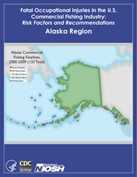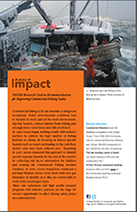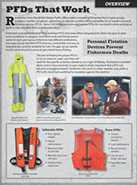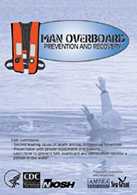COMMERCIAL FISHING SAFETY
Health Communication Solutions

The goal of the NIOSH fishing safety health communication group is to translate the results of the program’s epidemiologic and engineering research into products and tools that can be used directly by the industry to reduce injuries and fatalities among commercial fishermen. The health communication staff work closely with the researchers during project planning and implementation to collect qualitative information on fishermen’s communication preferences. Our program publishes a variety of information in NIOSH-numbered publications, industry trade journals, on the Internet and various social media platforms. A collection of our major program outputs can be found below:
Live to be Salty
 Falling overboard is the second leading cause of death among commercial fishermen, nationwide. And the reason for that? Not wearing a personal flotation device (PFD). In fact, none of the 191 fishermen who died in the U.S. between 2000 and 2013 were wearing a PFD when they drowned.
Falling overboard is the second leading cause of death among commercial fishermen, nationwide. And the reason for that? Not wearing a personal flotation device (PFD). In fact, none of the 191 fishermen who died in the U.S. between 2000 and 2013 were wearing a PFD when they drowned.
Live to be Salty is a multi-media health communication intervention developed by the National Institute for Occupational Safety and Health and our partners in an effort to reduce drownings, by promoting the use of PFDs on board commercial fishing vessels.
Live to be Salty means to take steps that will lead to a long and productive fishing career. Live to be the Old Salt everyone looks to for advice by setting a good example for your crew and others. PFDs have come a long way in the last decade and many of the myths associated with them simply aren’t true. There are comfortable PFDs available on the market that you can wear 100% of the time on deck. PFDs that don’t snag on gear, don’t overheat you, and won’t restrict your movement. We hope to spread that word and save lives.
Document Development and Publication
Regional Fatality Summaries
 After the development of the Commercial Fishing Incident Database (CFID), a series of regional fatality summaries were published to highlight high-risk fisheries in each area of the country.
After the development of the Commercial Fishing Incident Database (CFID), a series of regional fatality summaries were published to highlight high-risk fisheries in each area of the country.
Impact Sheets
 NIOSH uses Impact Sheets to summarize the impact our various research projects have among our stakeholders.
NIOSH uses Impact Sheets to summarize the impact our various research projects have among our stakeholders.
A Story of Impact: NIOSH Research Cited in Recommendations for Improving Commercial Fishing
A Story of Impact: PFD Manufacturer Adopts NIOSH Research into Product Development Process
PFDs That Work Fact Sheets
 One of the major outputs from our PFD safety project is a series of gear-specific PFD fact sheets that highlight the results of our PFD safety survey and evaluation. Each fact sheets talks about the attitudes opinions each gear type had about PFDs as well as the styles of PFDs they found acceptable to work in on deck. The series consists of an Overview sheet and then gear-specific results for crabbers, trawlers, gillnetters, and longliners.
One of the major outputs from our PFD safety project is a series of gear-specific PFD fact sheets that highlight the results of our PFD safety survey and evaluation. Each fact sheets talks about the attitudes opinions each gear type had about PFDs as well as the styles of PFDs they found acceptable to work in on deck. The series consists of an Overview sheet and then gear-specific results for crabbers, trawlers, gillnetters, and longliners.
Training Video Production
 The commercial fishing safety program has released three safety training videos to help educate commercial fishermen about deck safety and man overboard prevention and recovery.
The commercial fishing safety program has released three safety training videos to help educate commercial fishermen about deck safety and man overboard prevention and recovery.
You can find links to these videos on our Video Page.
Social Media
- Page last reviewed: June 8, 2015
- Page last updated: June 8, 2015
- Content source:
- National Institute for Occupational Safety and Health Office of the Director


 ShareCompartir
ShareCompartir